Development of CO2-Selective Polyimide-Based Gas Separation Membranes Using Crown Ether and Polydimethylsiloxane
Abstract
:1. Introduction
2. Materials and Methods
2.1. Materials
2.2. Synthesis of the CO2-Selective CE-PDMS-x Polymer (4)


2.3. Membrane Fabrication for CE-PDMS-x
3. Results and Discussion
3.1. Synthesis and Characterization of Polymers
3.2. Thermal Properties of the CE-PDMS-x Polymers
3.3. Morphology of CE-PDMS-x Membranes Determined Using AFM and Wide-Angle X-ray Diffraction (WAXD) Analysis
3.4. Gas-Separation Properties
3.5. Permeability Versus Selectivity
4. Conclusions
Supplementary Materials
Author Contributions
Funding
Institutional Review Board Statement
Informed Consent Statement
Acknowledgments
Conflicts of Interest
References
- Du, N.; Park, H.B.; Dal-Cin, M.M.; Guiver, M.D. Advances in high permeability polymeric membrane materials for CO2 separations. Energy Environ. Sci. 2012, 5, 7306–7322. [Google Scholar] [CrossRef] [Green Version]
- Wang, S.; Li, X.; Wu, H.; Tian, Z.; Xin, Q.; He, G.; Peng, D.; Chen, S.; Yin, Y.; Jiang, Z.; et al. Advances in high permeability polymer-based membrane materials for CO2 separations. Energy Environ. Sci. 2016, 9, 1863–1890. [Google Scholar] [CrossRef]
- Bui, M.; Adjiman, C.S.; Bardow, A.; Anthony, E.J.; Boston, A.; Brown, S.; Fennell, P.S.; Fuss, S.; Galindo, A.; Hackett, L.A.; et al. Carbon capture and storage (CCS): The way forward. Energy Environ. Sci. 2018, 11, 1062–1176. [Google Scholar] [CrossRef] [Green Version]
- Leung, D.Y.C.; Caramanna, G.; Maroto-Valer, M.M. An overview of current status of carbon dioxide capture and storage technologies. Renew. Sustain. Energy Rev. 2014, 39, 426–443. [Google Scholar] [CrossRef] [Green Version]
- Kim, D.; Hossain, I.; Kim, Y.; Choi, O.; Kim, T.H. PEG/PPG-PDMS-adamantane-based crosslinked terpolymer using the ROMP technique to prepare a highly permeable and CO2-selective polymer membrane. Polymers 2020, 12, 1674. [Google Scholar] [CrossRef] [PubMed]
- Hossain, I.; Kim, D.; Al Munsur, A.Z.; Roh, J.M.; Park, H.B.; Kim, T.H.; Hossain, I.; Kim, Y.; Choi, O.; Kim, T.H.; et al. PEG/PPG-PDMS-Based Cross-Linked Copolymer Membranes Prepared by ROMP and in Situ Membrane Casting for CO2 Separation: An Approach to Endow Rubbery Materials with Properties of Rigid Polymers. ACS Appl. Mater. Interfaces 2020, 12, 27286–27299. [Google Scholar] [CrossRef]
- Hossain, I.; Husna, A.; Chaemchuen, S.; Verpoort, F.; Kim, T. Cross-Linked Mixed-Matrix Membranes Using Functionalized UiO- 66-NH2 into PEG/PPG − PDMS-Based Rubbery Polymer for E fficient CO2 Separation. ACS Appl. Mater. Interfaces 2020, 12, 57916–57931. [Google Scholar] [CrossRef] [PubMed]
- Hossain, I.; Nam, S.Y.; Rizzuto, C.; Barbieri, G.; Tocci, E.; Kim, T.H. PIM-polyimide multiblock copolymer-based membranes with enhanced CO2 separation performances. J. Memb. Sci. 2019, 574, 270–281. [Google Scholar] [CrossRef]
- Hossain, I.; Al Munsur, A.Z.; Choi, O.; Kim, T.H. Bisimidazolium PEG-mediated crosslinked 6FDA-durene polyimide membranes for CO2 separation. Sep. Purif. Technol. 2019, 224, 180–188. [Google Scholar] [CrossRef]
- Robeson, L.M. Correlation of separation factor versus permeability for polymeric membranes. J. Memb. Sci. 1991, 62, 165–185. [Google Scholar] [CrossRef]
- Robeson, L.M. The upper bound revisited. J. Memb. Sci. 2008, 320, 390–400. [Google Scholar] [CrossRef]
- Sanaeepur, H.; Ebadi Amooghin, A.; Bandehali, S.; Moghadassi, A.; Matsuura, T.; Van der Bruggen, B. Polyimides in membrane gas separation: Monomer’s molecular design and structural engineering. Prog. Polym. Sci. 2019, 91, 80–125. [Google Scholar] [CrossRef]
- Zhuang, Y.; Seong, J.G.; Lee, Y.M. Polyimides containing aliphatic/alicyclic segments in the main chains. Prog. Polym. Sci. 2019, 92, 35–88. [Google Scholar] [CrossRef]
- Cecopieri-Gómez, M.L.; Palacios-Alquisira, J.; Domínguez, J.M. On the limits of gas separation in CO2/CH4, N2/CH4 and CO2/N2 binary mixtures using polyimide membranes. J. Memb. Sci. 2007, 293, 53–65. [Google Scholar] [CrossRef]
- Hossain, I.; Al Munsur, A.Z.; Kim, T.H. A facile synthesis of (PIM-polyimide)-(6FDA-durene-polyimide) copolymer as novel polymer membranes for CO2 separation. Membranes 2019, 9, 113. [Google Scholar] [CrossRef] [PubMed] [Green Version]
- Pei, X.; Chen, G.; Liu, J.; Fang, X. Influence of crystalline polyimide hard block on the properties of poly(imide siloxane) copolymers. Polymer 2015, 56, 229–236. [Google Scholar] [CrossRef]
- Gurr, P.A.; Scofield, J.M.P.; Kim, J.; Fu, Q.; Kentish, S.E.; Qiao, G.G. Polyimide polydimethylsiloxane triblock copolymers for thin film composite gas separation membranes. J. Polym. Sci. Part A Polym. Chem. 2014, 52, 3372–3382. [Google Scholar] [CrossRef]
- Park, J.; Gaines, K.E.; Jheng, L.C.; Riffle, J.S.; Mecham, S.J.; McGrath, J.E.; Park, H.B.; Paul, D.R.; Freeman, B.D. Characterization and gas transport properties of UV-irradiated polydimethylsiloxane (PDMS)-containing polyimide copolymer membranes. Polymer 2020, 210, 122966. [Google Scholar] [CrossRef]
- Martínez-Haya, B.; Hurtado, P.; Hortal, A.R.; Hamad, S.; Steill, J.D.; Oomens, J. Emergence of symmetry and chirality in crown ether complexes with alkali metal cations. J. Phys. Chem. A 2010, 114, 7048–7054. [Google Scholar] [CrossRef]
- Maruyama, Y.; Matsugami, M.; Ikuta, Y. Probing cations recognized by a crown ether with the 3D-RISM theory. II. 18-crown-6 ether. Condens. Matter. Phys. 2007, 10, 315–322. [Google Scholar] [CrossRef] [Green Version]
- Wu, D.; Yi, C.; Wang, Y.; Qi, S.; Yang, B. Preparation and gas permeation of crown ether-containing co-polyimide with enhanced CO2 selectivity. J. Memb. Sci. 2018, 551, 191–203. [Google Scholar] [CrossRef]
- Wu, D.; Yi, C.; Doherty, C.M.; Lin, L.; Xie, Z. A Crown Ether-Containing Copolyimide Membrane with Improved Free Volume for CO2 Separation. Ind. Eng. Chem. Res. 2019, 58, 14357–14367. [Google Scholar] [CrossRef]
- Wang, X.; Wang, X.; Ye, G. Hydrogel diffraction gratings functionalized with crown ether for heavy metal ion detection. Sens. Actuators B Chem. 2014, 193, 413–419. [Google Scholar] [CrossRef]
- Li, Y.; Zhao, J.Q.; Yuan, Y.C.; Shi, C.Q.; Liu, S.M.; Yan, S.J.; Zhao, Y.; Zhang, M.Q. Polyimide/crown ether composite films with necklace-like supramolecular structure and improved mechanical, dielectric, and hydrophobic properties. Macromolecules 2015, 48, 2173–2183. [Google Scholar] [CrossRef]
- Ku, C.K.; Lee, Y.-D. Microphase separation in amorphous poly(imide siloxane) segmented copolymers. Polymer 2007, 48, 3565–3573. [Google Scholar] [CrossRef]
- You, H.; Hossain, I.; Kim, T.H. Piperazinium-mediated crosslinked polyimide-polydimethylsiloxane (PI-PDMS) copolymer membranes: The effect of PDMS content on CO2 separation. RSC Adv. 2018, 8, 1328–1336. [Google Scholar] [CrossRef] [Green Version]
- Semsarzadeh, M.A.; Ghahramani, M. The effect of poly(alkyl (meth)acrylate) segments on the thermodynamic properties, morphology and gas permeation properties of poly(alkyl (meth)acrylate)-b-poly(dimethyl siloxane) triblock copolymer membranes. J. Memb. Sci. 2020, 594, 117400. [Google Scholar] [CrossRef]
- Fan, J.; Huang, J.; Yan, M.; Gong, Z.; Cao, L.; Chen, Y. Thermoplastic multifunctional polysiloxane-based materials from broad gradient-transition multiphase separation. J. Mater. Chem. A 2020, 8, 16376–16384. [Google Scholar] [CrossRef]
- Schauer, J.; Sysel, P.; Maroušek, V.; Pientka, Z.; Pokorný, J.; Bleha, M. Pervaporation and gas separation membranes made from polyimide/polydimethylsiloxane block copolymer. J. Appl. Polym. Sci. 1996, 61, 1333–1337. [Google Scholar] [CrossRef]
- Ren, L.; Liu, J. Synthesis and gas transport properties of polyamide membranes containing PDMS groups. RSC Adv. 2019, 9, 9737–9744. [Google Scholar] [CrossRef] [Green Version]
- Hong, T.; Cao, P.F.; Zhao, S.; Li, B.; Smith, C.; Lehmann, M.; Erwin, A.J.; Mahurin, S.M.; Venna, S.R.; Sokolov, A.P.; et al. Tailored CO2-philic Gas Separation Membranes via One-Pot Thiol-ene Chemistry. Macromolecules 2019, 52, 5819–5828. [Google Scholar] [CrossRef]
- Ha, S.Y.; Park, H.B.; Lee, Y.M. Percolational effect of siloxane content in poly(amideimide siloxane) on the gas permeation behavior. Macromolecules 1999, 32, 2394–2396. [Google Scholar] [CrossRef]
- Coleman, M.R.; Koros, W.J. Isomeric polyimides based on fluorinated dianhydrides and diamines for gas separation applications. J. Memb. Sci. 1990, 50, 285–297. [Google Scholar] [CrossRef]
- Hamad, F.; Matsuura, T. Performance of gas separation membranes made from sulfonated brominated high molecular weight poly(2,4-dimethyl-l,6-phenyIene oxide). J. Memb. Sci. 2005, 253, 183–189. [Google Scholar] [CrossRef]
- Şen, D.; Kalipçilar, H.; Yilmaz, L. Gas separation performance of polycarbonate membranes modified with multifunctional low molecularweight additives. Sep. Sci. Technol. 2006, 41, 1813–1828. [Google Scholar] [CrossRef]
- Yong, W.F.; Li, F.Y.; Xiao, Y.C.; Li, P.; Pramoda, K.P.; Tong, Y.W.; Chung, T.S. Molecular engineering of PIM-1/Matrimid blend membranes for gas separation. J. Memb. Sci. 2012, 407–408, 47–57. [Google Scholar] [CrossRef]
- Qiu, W.; Xu, L.; Chen, C.C.; Paul, D.R.; Koros, W.J. Gas separation performance of 6FDA-based polyimides with different chemical structures. Polymer 2013, 54, 6226–6235. [Google Scholar] [CrossRef]
- Park, H.B.; Kim, J.K.; Nam, S.Y.; Lee, Y.M. Imide-siloxane block copolymer/silica hybrid membranes: Preparation, characterization and gas separation properties. J. Memb. Sci. 2003, 220, 59–73. [Google Scholar] [CrossRef]
- Nagase, Y.; Naruse, A.; Matsui, K. Chemical modification of polysulphone: 2. Gas and liquid permeability of polysulphone/polydimethylsiloxane graft copolymer membranes. Polymer 1990, 31, 121–125. [Google Scholar] [CrossRef]
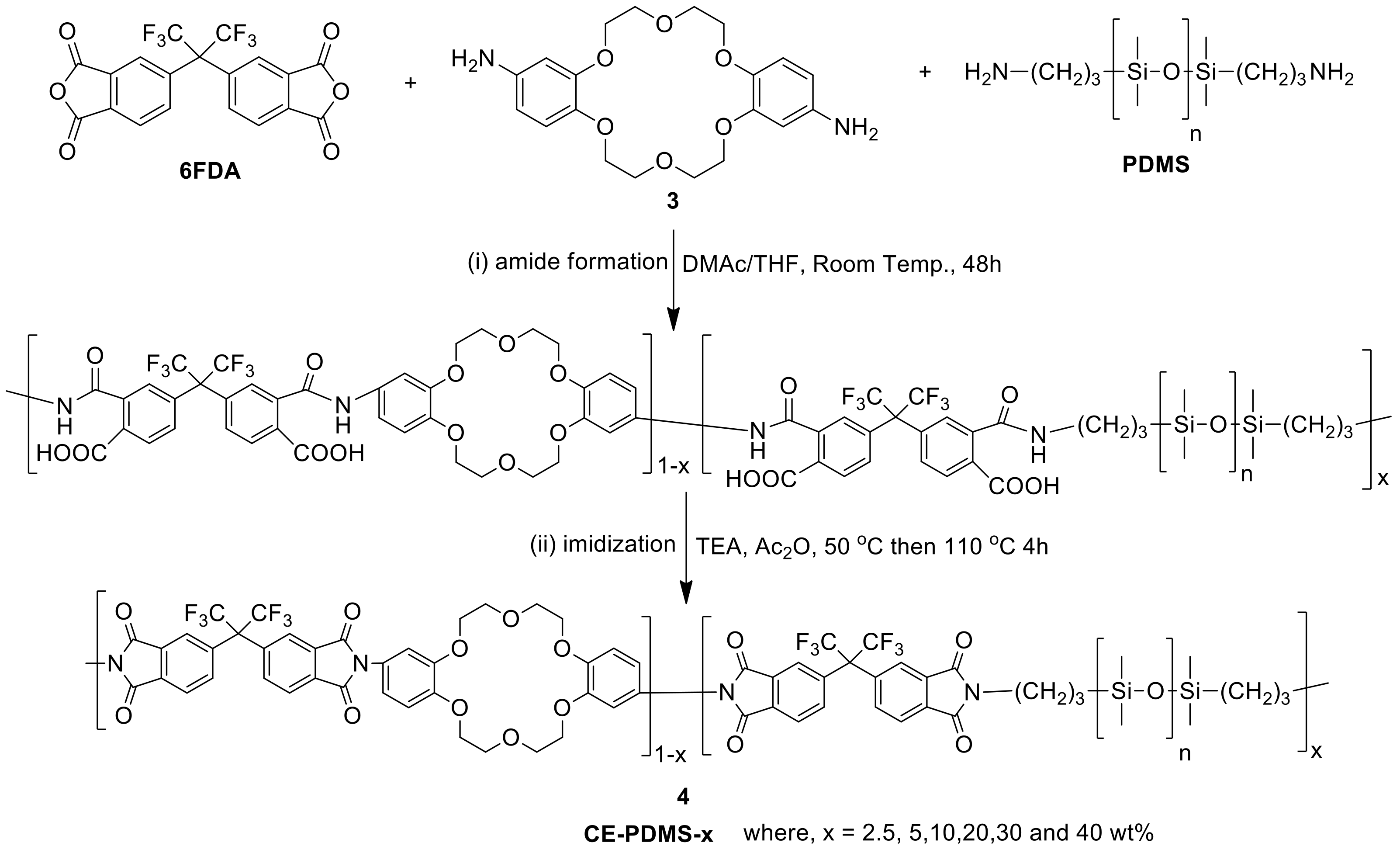

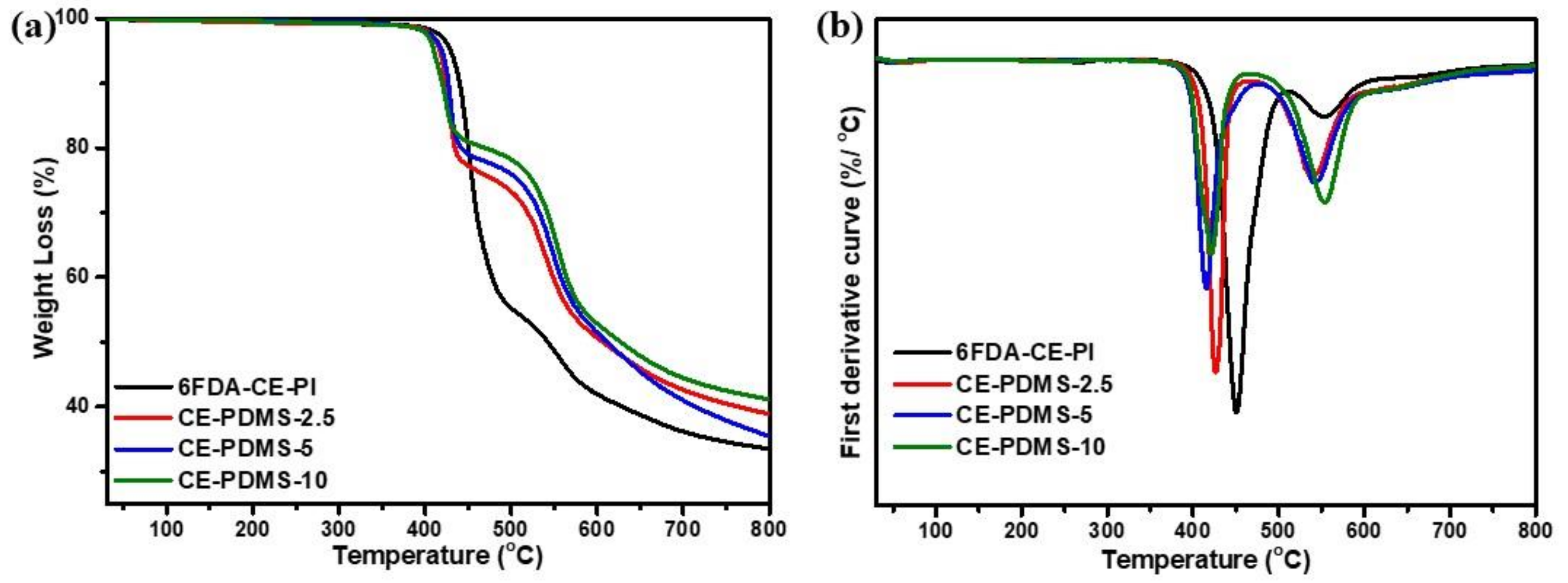
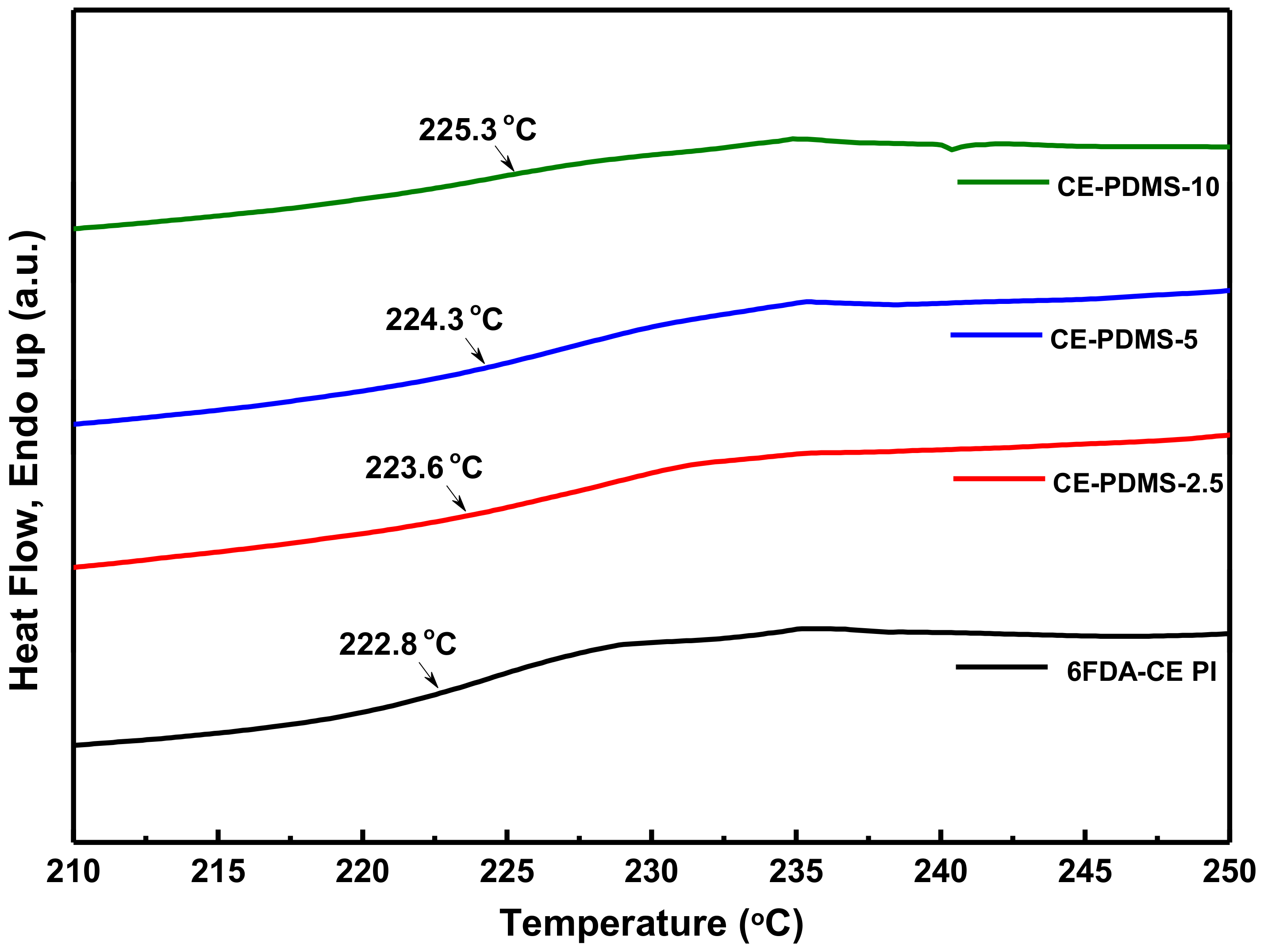


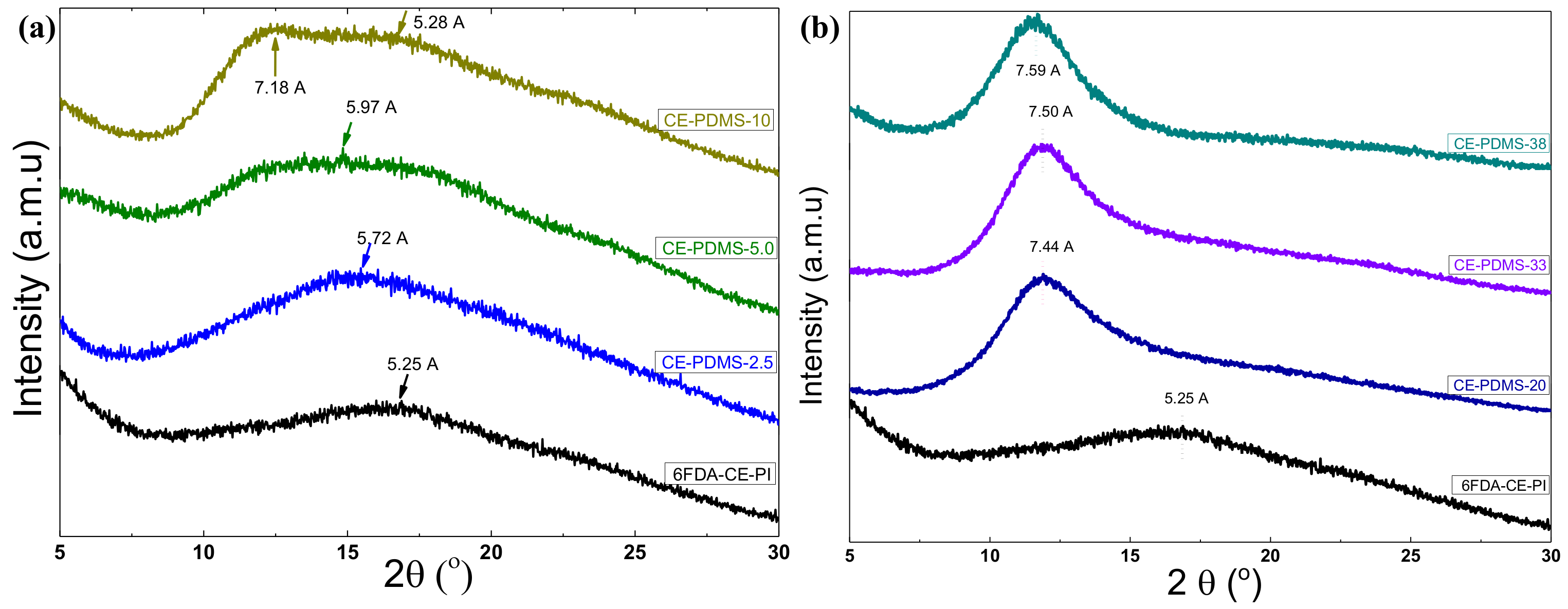
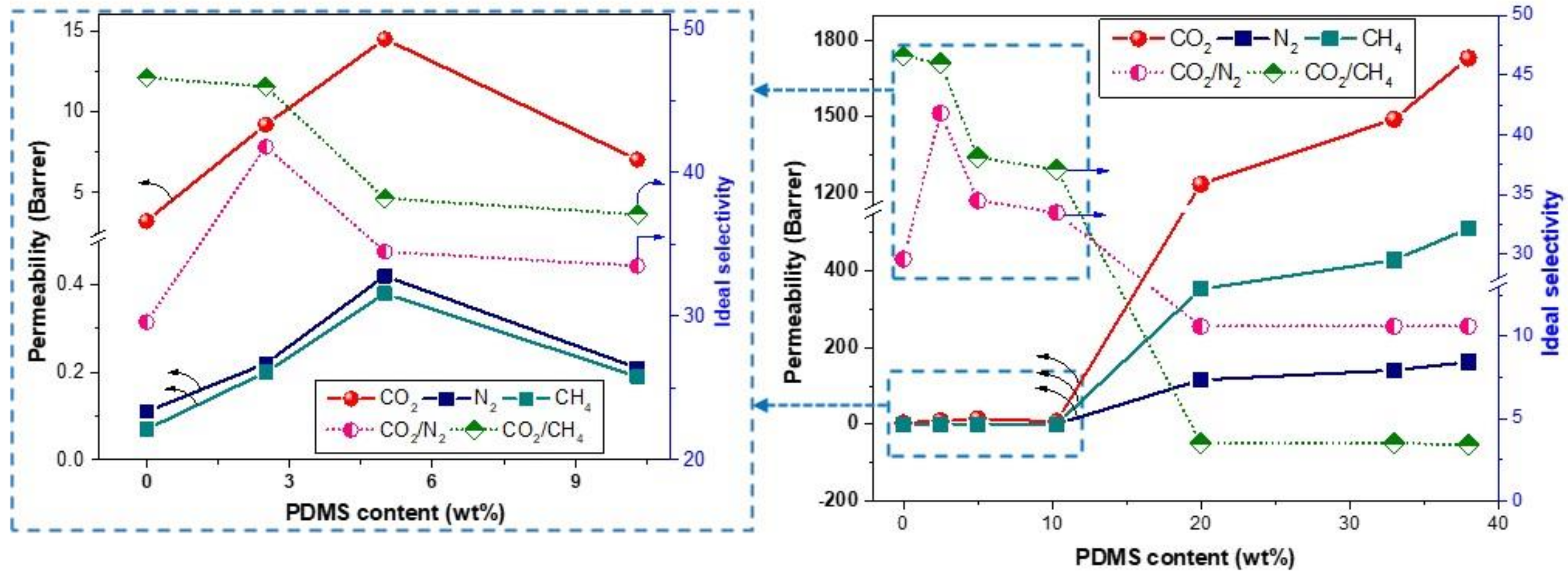

| Membrane | Mn/104 | Mw/104 | Polydispersity Index (PDI) | Thickness (μm) | d-Spacing (Å) | |
|---|---|---|---|---|---|---|
| I | II | |||||
| 6FDA-CE-PI | 4.50 | 7.62 | 1.69 | 58 | 5.25 | - |
| CE-PDMS-2.5 | 2.75 | 5.92 | 2.15 | 28 | 5.75 | - |
| CE-PDMS-5 | 2.26 | 5.02 | 2.22 | 29 | 5.97 | - |
| CE-PDMS-10 | 2.38 | 5.05 | 2.12 | 24 | 5.28 | 7.18 |
| CE-PDMS-20 | 2.39 | 4.77 | 2.00 | 50 | - | 7.44 |
| CE-PDMS-30 | 2.69 | 10.74 | 3.99 | 60 | - | 7.50 |
| CE-PDMS-40 | 3.43 | 8.44 | 2.46 | 65 | - | 7.59 |
| Membrane | Permeability (Barrer) a | Selectivity (α) | |||
|---|---|---|---|---|---|
| CO2 | N2 | CH4 | CO2/N2 | CO2/CH4 | |
| 6FDA-CE-PI | 3.26 | 0.11 | 0.07 | 29.6 | 46.6 |
| CE-PDMS-2.5 | 9.20 | 0.22 | 0.20 | 41.8 | 46 |
| CE-PDMS-5 | 14.48 | 0.38 | 0.42 | 34.5 | 38.1 |
| CE-PDMS-10 | 7.04 | 0.21 | 0.19 | 33.5 | 37.1 |
| CE-PDMS-20 | 1234 | 116 | 353 | 10.6 | 3.5 |
| CE-PDMS-30 | 1490 | 141 | 429 | 10.6 | 3.5 |
| CE-PDMS-40 | 1731 | 163 | 511 | 10.6 | 3.4 |
Publisher’s Note: MDPI stays neutral with regard to jurisdictional claims in published maps and institutional affiliations. |
© 2021 by the authors. Licensee MDPI, Basel, Switzerland. This article is an open access article distributed under the terms and conditions of the Creative Commons Attribution (CC BY) license (https://creativecommons.org/licenses/by/4.0/).
Share and Cite
Kim, D.; Hossain, I.; Husna, A.; Kim, T.-H. Development of CO2-Selective Polyimide-Based Gas Separation Membranes Using Crown Ether and Polydimethylsiloxane. Polymers 2021, 13, 1927. https://doi.org/10.3390/polym13121927
Kim D, Hossain I, Husna A, Kim T-H. Development of CO2-Selective Polyimide-Based Gas Separation Membranes Using Crown Ether and Polydimethylsiloxane. Polymers. 2021; 13(12):1927. https://doi.org/10.3390/polym13121927
Chicago/Turabian StyleKim, Dongyoung, Iqubal Hossain, Asmaul Husna, and Tae-Hyun Kim. 2021. "Development of CO2-Selective Polyimide-Based Gas Separation Membranes Using Crown Ether and Polydimethylsiloxane" Polymers 13, no. 12: 1927. https://doi.org/10.3390/polym13121927








